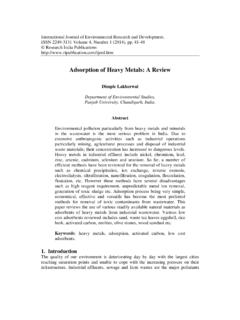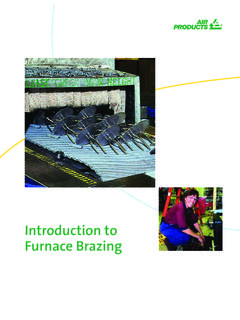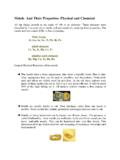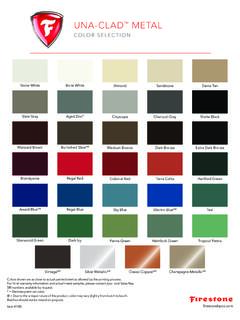Transcription of Principles and Applications
1 ACOUSTICAL USES FOR PERFORATED METALS: Principles and Applications by Theodore J. Schultz, ACOUSTICAL USES FOR PERFORATED METALS Table of Contents PART ONE: THE Principles I. Introduction A. How Perforated Metals are Used in Acoustical Applications 1. As a Facing for Something Else 2. In Tuned Resonators 3. As Airflow Diffusers B. Noise Control with Sound Absorptive Treatments Using Perforated Metals II. Matching the Sound Absorption to the Frequencies Where the Noise Problem Lies A. Frequency Analysis B. Sound Level meter C. Frequency Spectrum D. Frequency Spectra for Some Household Equipment III. The Transparency Approach A. Perforated metal Sheet with High Transparency for Use in Broad-band Sound Absorptive Treatments B. Why Perforated Metals Are Often the Best Choice C.
2 Sound Transparency of Perforated metal IV. The Tuned Resonator Absorber Approach A. Perforated metal Sheet with Properties Chosen to Target a Limited Range of Frequencies for Optimum Sound Absorption B. Calculating the Dimensions of the Tuned Absorber to Give the Desired Resonance Frequency C. Design Refinements 1 2 2 2 2 3 4 5 6 7 9 11 11 13 14 21 21 23 29 This booklet was published by the Industrial Perforators Association, Inc. Market Development Committee, J. Lee Plank, Jr. Chairman. Editorial Consultant Charles Turpin & Co., Inc. Industrial Perforators Association, Inc. 1986 All Rights Reserved Table of Contents, Continued PART TWO: THE Applications I. Introduction II. The Transparency Approach A. Sound Attenuation at High Frequencies B. Access to the Sound Treatment C.
3 How to Use the Access Factor D. A Case History Illustrating the Transparency Approach E. Special Considerations: Non-Circular Perforations and Self-Resistance of the Perforated metal III. Resonant Sound Absorbers A. Sound Absorption at the Resonance Frequency 1. Flow Resistance, Flow Resistivity, and Resistance Ratio 2. Absorptive Layer Near a Hard Wall 3. Resonance Frequencies Achievable with Commonly Produced Perforated metal Sheets B. The Absorption Bandwidth C. Combined Effects of Flow Resistance, Filling, and Absorber Dimensions 1. The Proper Choice for R 2. Further Illustrative Examples 3. Self-Flow-Resistance of Fine Perforated metal Screens IV. Practical Large-Scale Applications or Sound-Absorptive Treatments Using Perforated Metals A. Barrier Screens for Tokyo Roadways B.
4 Absorptive Barriers and Ceiling Treatments in the Vienna Subway System C. Acoustical Effects of the Sound Absorptive Treatment in the Vienna Subway D. Sound Attenuation and Access Factors for these Treatments Appendix A: Thickness of Sound Absorptive Treatments and Sound Absorption at Low Frequencies Appendix B: Background for the Transparency Index and the Attenuation of Perforated metal at High Frequencies Appendix C: The Access Factor and Access of the Sound Wave to the Sound Absorptive Treatment Lying Behind the Perforated metal Appendix D: Work Sheets (Figures 17, 21, 22, and 23) 31 31 32 33 34 48 40 41 41 42 45 46 47 48 51 51 56 59 59 60 62 63 65 67 71 72 Page 1 of 76 ACOUSTICAL USES FOR PERFORATED METALS: PART ONE: THE Principles I. Introduction Of all the markets for perforated metals, acoustical Applications have seen the most dramatic growth in the last few decades.
5 There is every reason to expect a further surge of growth in this area in the near future, to match that of the general economy. Much of the new growth in the acoustical market will come from original equipment manufacturers (OEM) and from architectural firms. OEM s will find that they must reduce the noise of their products to meet consumer demands, and the architects (including highway, airport, and rapid transit designers) are already designing noise control into their projects; these Applications will proliferate as commercial building and government construction pick up. In order to take full advantage of this potential market development, it is important to ensure that the designers of noise control Applications give full consideration to the use of perforated materials, and to present a convincing argument that perforated materials are often the best alternative in noise control programs.
6 The best way of doing this is to present up-to-date, factual information on the acoustical Applications of perforated materials and to illustrate these uses with enough practical examples to help specifiers gain a sense of confidence in recommending the right material for the right application, without feeling intimidated by the technical aspects of the design. It is the purpose of this booklet to provide the necessary technical information in an easy-to-use style, and to provide helpful hints in the choice of perforated metals, so that professionals can recommend these materials to their clients with pride and confidence. Page 2 of 76 A. How Perforated Metals Are Used in Acoustical Applications There are three principal acoustical Applications for perforated metals: 1.
7 As a Facing for Something Else: Here the perforated metal is used as a protective or decorative covering for some special acoustical material; that material may be designed either to absorb sound or to reflect or scatter sound in a special way. It is this special material that does the actual acoustical work, so the purpose of the perforated metal in such Applications is to "disappear" acoustically: that is, it must be so trans parent that the sound waves can pass right through it to encounter the acoustical treatment that lies behind. Our design goal in this case is to choose the perforated metal for greatest sound transparency, for sounds of all frequencies. 2. In Tuned Resonant Sound Absorbers: Sometimes, however, we may wish to absorb sound very selectively, only in a certain band of frequencies but not at frequencies lying above and below that band.
8 For this purpose we design a so-called Resonant Sound Absorber. Here, the perforated metal , instead of disappearing, takes an active part in tuning the aborber, that is, in determining which frequencies of sound are absorbed. 3. As Airflow Diffusers: In the acoustical treatment of certain specialized aerodynamic test facilities, such as wind tunnels, perforated metals are often used to break up the turbulence in airflows. This last application is both highly specialized and highly technical. Moreover, it does not represent a significant portion of the market; therefore, the rest of this book will be concerned entirely with the first two Applications . The main text of this book is intended for readers with no special technical background. It is divided into two parts. The first part deals with the Principles of noise control treatments using perforated metals; the second part deals with typical Applications .
9 Readers who want more technical detail will find it in the Appendices. Appendix D also includes worksheets that may be photocopied, filled out and included in the job files for individual projects. Figure 1. As an example of the first application, the curved surfaces above the stage of the Orpheum Theatre, Vancouver, , are made of finely perforated metal sheet, not of plaster as they appear. The perforations allow the sound to pass through and to reflect back into the hall at desired locations, from specially designed surfaces behind the perforated metal . Page 3 of 76 B. Noise Control With Sound Absorptive Treatments Using Perforated Metals Noise control measures are often applied in order to quiet noisy equipment. We treat various household and office appliances to make them acceptable to the user because excessive noise is annoying; we treat heavy industrial equipment so that it will comply with current OSHA regulations that limit the noise exposure of workers so as to protect them from hearing damage.
10 In 1970, the Occupational Safety and Health Act (OSHA) set limits on the levels of noise to which workers may be exposed in their work environments. This regulation requires that industries monitor the noise in all worker locations, and, where this noise exceeds the permissible limits, it must be abated by any feasible noise control measures, or by administrative methods such as limiting the employees' exposure time. If such noise control procedures turn out not to be feasible, then hearing protection must be provided for the workers. One effective and commonly used approach is to CONTAIN the noise by providing an enclosure around the noisy equipment. This approach can work very well, so long as we attend to one very important matter: we must provide sound-absorptive treatment inside the enclosure, to soak up as much sound as possible.







